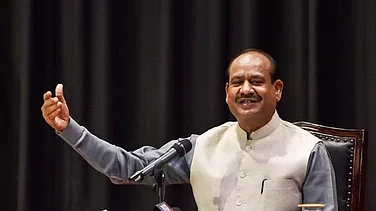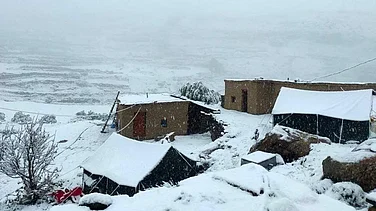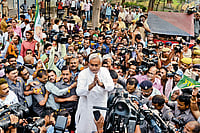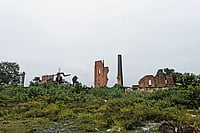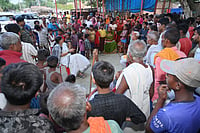On June 17, nine-year-old Ruchi and her six-year-old sister Rakhi, residents of Sonadia village in Bhojpur district of Bihar, sneaked out of their home at 3 PM and went to a nearby mango orchard to pick mangoes. Both returned in half an hour, sweating profusely. Within minutes they started vomiting and had loose motions.
Vicky Choudhary, their father, got some medicines from the nearby shop, but the pills did not work. “We thought we would be able to deal with it at home, but their condition went from bad to worse,” says Rakesh Choudhary, the uncle of the girls. At 4 AM, the family had to rush the girls to a government hospital. But by the time they reached, Rakhi passed away. Ruchi was admitted and her treatment started. When she started recovering, the family got her admitted to a private hospital as a precautionary measure.
The family performed the last rites of Rakhi, but no post-mortem was conducted. “That day it was very hot and Rakhi had just returned from the orchard. We assumed she had fallen sick due to the severe heat. Even the doctor at the private hospital where Ruchi was admitted said she had taken ill due to heat stroke,” says their uncle Rakesh.
In the absence of a post-mortem report, Rakhi’s name would not make it to the list of people who have succumbed to heat wave in Bihar in the past few days. The official figure stands at just nine. However, the unofficial numbers say more than 40 people have died so far. Hundreds are undergoing treatment at various hospitals. Choudhary, the father of Rakhi and Ruchi, works as a daily wager. He now has to give away a portion of his land on mortgage to foot the private hospital bill.
Severe Heat Wave in the North
On the day Rakhi died, mercury was hovering at 44.5 degrees Celsius in Bhojpur—eight degrees above normal. The Indian Meteorological Department (IMD) issued a warning regarding the “severe heat wave” and urged people to stay indoors to avoid exposure to the extreme heat that could lead to heat stroke.
In fact, on June 17, 18 districts of Bihar were reeling under a “severe heat wave” and four under a “heat wave”. As per the IMD figures, the temperature was 6-9 degrees above normal.
The state has been dealing with severe heat wave conditions since the first week of June. On June 1, the temperature recorded was 41.3 degree Celsius, 4.6 degrees above normal. On June 4, the Patna centre of IMD issued a press release which said: “According to the analysis of the numerical model of the IMD, there is a possibility of an increase of 2-3 degree Celsius in the temperature in the state from June 4 to June 11.” Since then, most parts of the stat, especially south and central Bihar, have been reeling under severe heat waves.
Effect of Cyclone Biparjoy
According to weather department officials, in the past decade, this is the first time that the state is dealing with such a prolonged period of heat wave. Experts attribute the severe heat wave condition to westerly wind and cyclone Biparjoy.
Professor (Dr) Pradhan Parth Sarthi, who is Meteorologist and Dean, School of Earth, Biological and Environmental Sciences at the Central University of South Bihar, says: “North India is experiencing a heat wave because of westerly wind which is currently very strong and dry. This is leading to clouds not being formed as a result of which the sun’s radiation is directly reaching the earth’s surface causing an increase in surface temperature.” The condition is likely to be the same or may worsen until easterly wind, which flows from the Bay of Bengal to Bihar becomes active, brings moisture and leads to cloud formation, he adds.
According to him, cyclone Biparjoy, which made landfall on June 16 near the Gujarat-Pakistan border is the main culprit of the prolonged heat wave conditions in North India, including Bihar. Cyclone Biparjoy originated in the Arabian Sea where cyclonic circulation is a rare occurrence unlike in the Bay of Bengal.
“Normally, there is a duration of 5-6 days between a cyclone’s formation and landfall but in the case of Biparjoy, there was a time gap of around 10 days which helped westerly wind to stay strong in the northern part of India for a longer time,” says Parth Sarthi.
According to him, there is an indirect link between heat waves and climate change. “The Arabian Sea is getting warmer due to climate change and this warming has resulted in cyclone Biporjoy which has contributed to the prevailing heat wave condition,” he says.
Recurring Heat Waves
Severe heat wave had created a havoc in Bihar in 2019 as well. That year, the condition was so severe that for the first time in the history, the Bihar government had to impose Section 144 to prohibit people from stepping out between 11 AM and 4 PM. In 2019, as per the official numbers, 142 people had died due to heat stroke in just one week. Though, the local newspapers claimed that more than 300 had died.
This year too, the heat wave has been brutal and people have been thronging to clinics and jhola chhap doctors (quacks) for treatments. In Bihar, many people prefer going to a jhola chhap doctors and they are very popular.
Rakesh Ranjan, a jhola chhap doctor from Dhaka in East Champaran, says: “Almost every day people are coming to us complaining of heat stroke symptoms. Based on the training given to us by the government, we first check the patient’s blood pressure and then the body temperature. If the condition is not serious, we give ORS and other medicines. If the case is serious, we refer them to government hospitals.”
The hospitals are all set too. “We have treated 20 patients suffering from heat wave in the last 10 days. We have kept 10 beds in the government hospitals for heat wave patients,” says KN Tiwari, a civil surgeon based in Rohtas district.
Data Discrepancy
The disparity in official and unofficial numbers of deaths due to heat stroke is proving to be detrimental to tackling the issue at hand.
According to the experts, the state government’s data collection is very poor and the surveillance system is fragile. That is why many deaths due to the prevailing heat wave have gone unreported and these deaths are not taken into consideration while counting the official numbers.
Currently, there is a team of three health officials in every district to monitor heat stroke-related deaths. While explaining how it is determined if a person has died due to heat stroke, a district-level doctor says: “If a person is admitted to a government hospital with heat stroke-like symptoms and dies, then we take into consideration some symptoms like headache, high fever, diarrhea and vomiting and then conclude that the person has died due to heat stroke.” Another doctor from the health department says that apart from these three crucial factors, the medical history of the patient is also taken into consideration. “We do ask the patients questions like for how long they were exposed to heat,” he says.
Ironically, all these symptoms can be assessed only if patients are admitted to government hospitals. So there remains ample scope for underreporting as deaths at private hospitals and homes are not taken into consideration.
Dr Sunil Kumar, state secretary of the Indian Medical Association (IMA), Bihar chapter, says that the data collection system in Bihar is in extremely poor condition. “There is no system of collection of (heat stroke-related death) data from private hospitals. Most people are not well informed and they try to treat such patients at home rather than bringing them to government hospitals. When patients die, families perform the last rites without bothering about getting a post-mortem done,” he says. He believes that in the case of heat stroke, data is hugely underreported. “I think, the actual death numbers are higher than the official data,” says Dr Kumar.
Another way of identifying the cause of death is a forensic investigation of the viscera of the dead person. But, it is time-consuming and the health department does not conduct a post-mortem to identify the cause of death in heat stroke cases. A senior doctor with the Bihar health department, who is a part of the team that conducts post-mortem, informs: “A simple post-mortem report does not confirm heat-stroke related death. For this, examination of viscera is necessary.”
He adds: “In serious cases, the viscera is preserved at the time of post-mortem and sent to the forensic lab. If the death is due to heat stroke, then the viscera test report shows that some body organs were dehydrated. However, it takes two-three months for the forensics reports to arrive.”
Impact on livelihood
The severe heat wave is not only claiming lives but is also affecting the livelihood of the poor daily wage earners.
At 11 AM, Raju Paswan, 45, a lanky rickshaw puller from rural Patna, was taking his last passenger of the day. His thin light blue shirt was soaked in sweat and was sticking to his body. He had covered his head with a saffron gamcha to protect himself from the sun. A big bottle of water was kept beneath his seat. “Bhari loo gir raha hai lekin bahar nahi niklenge to kamayenge kaise?” he asks. (There is a severe heat wave, but if we won’t step out, how will we earn).
For the last two weeks, he has changed the time of rickshaw pulling. Earlier, he would work the whole day, but now he works in shifts—from 6 AM to 11 AM and from 5 PM to 9 PM. This change in schedule has halved his income. “Earlier, I used to earn Rs 500-600, but now I hardly earn Rs 200-300. But there is no option. I have to take care of my health as well,” says Paswan who lives with his wife, two daughters and a son.
To beat the heat, he drinks boiled mango sharbat every morning and covers his head with a gamcha when he steps out. He drinks a lot of water to keep himself hydrated.
Like Raju, e-rickshaw driver Sunil Paswan’s income has halved—from Rs 1,000 a day earlier, to Rs 400-500 now.
“I don’t drive in the afternoon these days. Not operating the e-rickshaw for 5-6 hours has led to reduced income, but there is no option,” he says. Pawan, who has two children studying in a government school, lives in a jhuggi with his family. “The government says that they have made provisions for drinking water on roadsides, but you will not find these on Bailey Road. The government claims that they are doing a lot for the poor, but in reality, nothing is being done.”
In March this year, the state’s Disaster Management Department issued several guidelines in view of the forecast of severe heat wave, which included making drinking water available in public places, keeping a stock of medicines at workplaces, temporary day shelters for workers, adequate supply of ORS and life-saving drugs in government hospitals and health centers, and flexibility in working hours of construction workers. But, disappointingly, no provision has been made for providing compensation to thousands like Paswans who are not able to earn enough due to the heat wave.
Paswan is not expecting anything from the government. “Gareeb ko dekhne wala koi nahi hai. Sarkar uski hi madad karti hai jiska pairvi hai,” he says. (There is no one to help us. The government helps only those who are well-connected).
Umesh Kumar Ray is a Bihar-based independent journalist









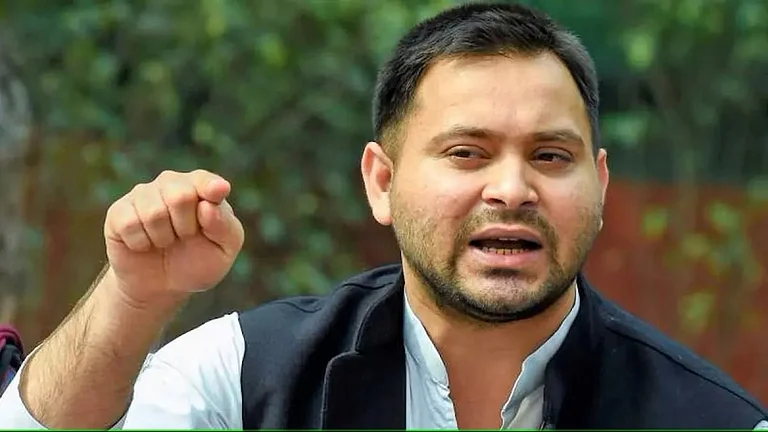
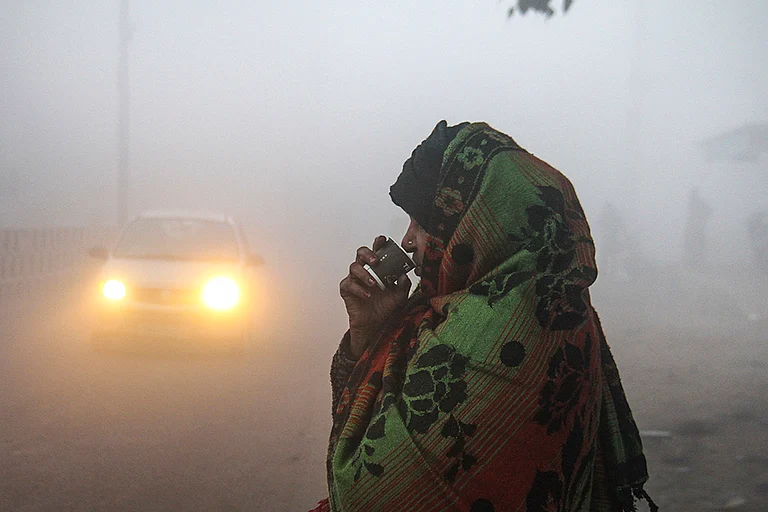
.jpg?auto=format%2Ccompress&fit=max&format=webp&w=768&dpr=1.0)

